Action Templates
Action templates are pre-built, reusable frameworks that simplify the process of creating chatbot actions. These templates act as a starting point for implementing common tasks like generating leads, creating a support ticket, or gathering feedback.
tip
By using action templates, you can immediately get a head start in creating actions and later focus on customizing them to meet your specific requirements. This also smoothens the learning curve, enabling you to create your own actions with greater ease and creativity.
Below are step-by-step guides for using different action templates. Click to expand and learn how to configure them for your chatbot.
📒 How to Set Up a Lead Action ?
Leads Collection Action Template#
Click on the bot for which you want to set up the Action. Navigate to Actions in the top menu, and select Lead from the list.

You'll see a input
JSONtemplate designed to collect leads. You can also customize thisJSONto suit your requirements.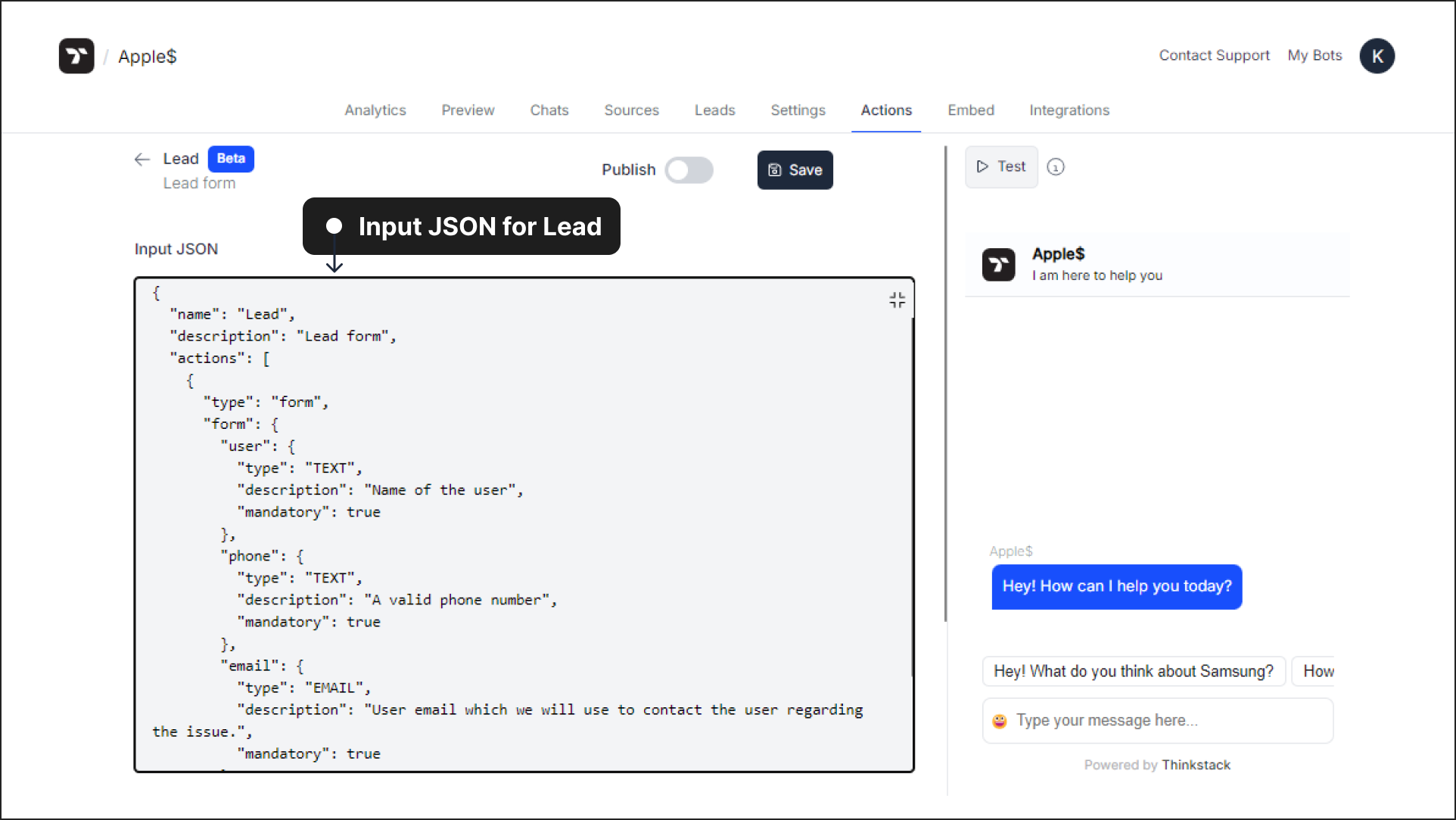
If you want to automate the flow of action with third-party apps like Zapier, click Integrate. This step will trigger the Zap you have already set up. This step is optional.

Set the Trigger to help the chatbot identify when to start the lead generation action. Carefully provide the triggers. The best practice is to use 2-3 distinct triggers to assist the chatbot in recognizing the intent.
 Note: Ensure the triggers you set are not the same as those used for Human-Handoff. If similar triggers are used, the chatbot will perform Human-Handoff instead of the lead action.
Note: Ensure the triggers you set are not the same as those used for Human-Handoff. If similar triggers are used, the chatbot will perform Human-Handoff instead of the lead action.After setting the triggers, toggle the Publish button to activate the lead action. Click on 'Save' as this will save the changes/selection you have made so far with respect to the chatbot.

Lead Collection Action: Advanced Settings#
If you want to initiate the action by adding it as a suggestion you can easily do so.
Open the Advanced dropdown and toggle 'Show in Suggestions.
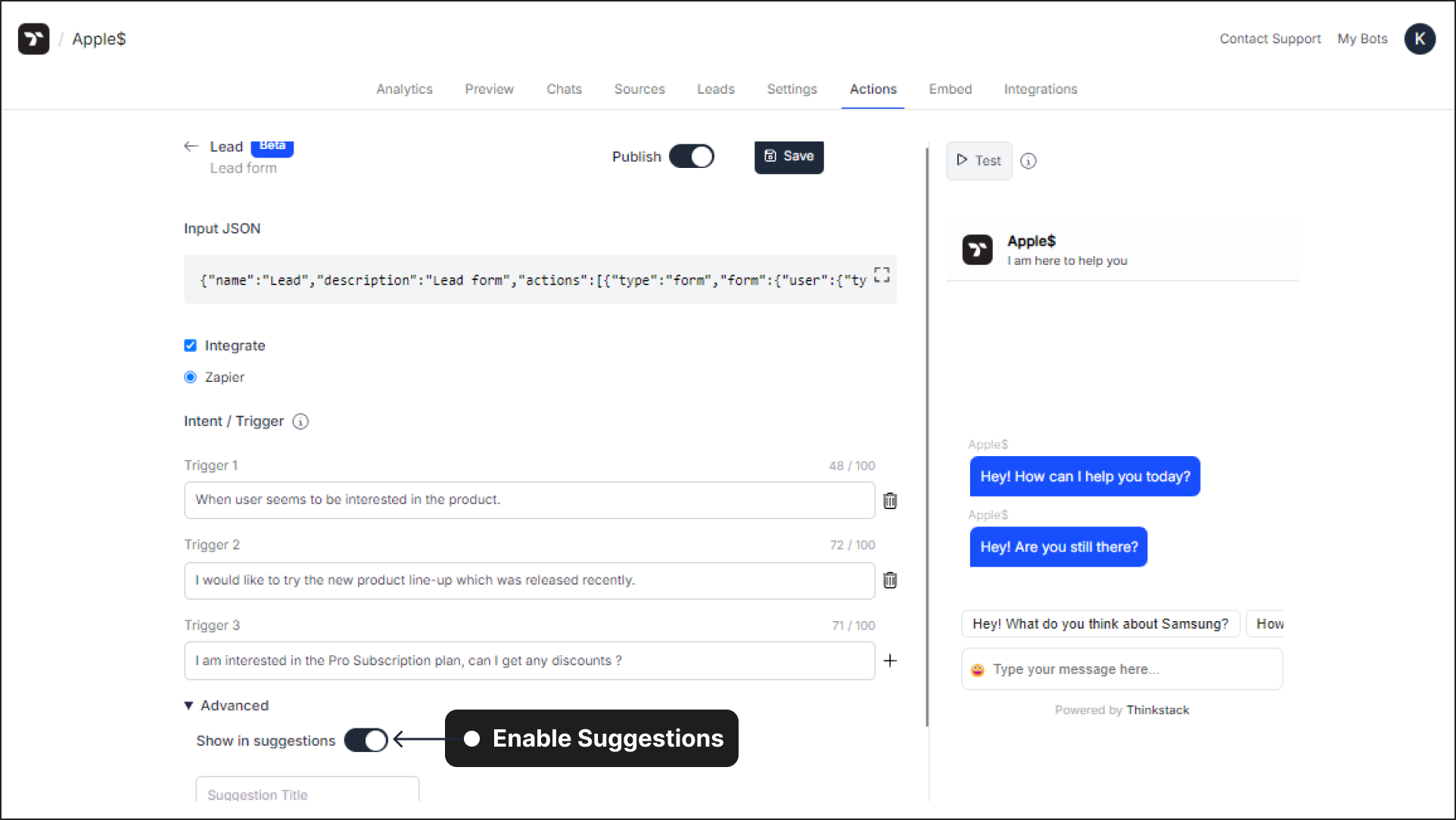
Provide a Suggestion Title. When users click on it, the lead action will be triggered.

Click on 'Update' to apply the new changes to your chatbot.

Test the Lead Collection Action#
Use the Test feature to verify that the chatbot is requesting the fields as configured in the
.jsonfile.
You can also test it in the Preview section to check if the chatbot correctly identifies user interest and initiates the lead action.

View the Leads#
Once the chatbot successfully collects the lead, the details can be viewed by clicking on the Lead list in the Action section.


That's a wrap🎉, you have set up an intent-driven Lead Action that will automatically collect lead information when the chatbot detects user interest.
📞 How to Set Up a Talk to Sales Action ?
Talk to Sales Action Template#
Click on the bot for which you want to set up the action. Navigate to the Actions tab in the top menu and select Talk to Sales from the list.

A
JSONtemplate will appear, pre-configured to collect contact details such as name, email, and phone number to allow the sales team to reach out. You can customize this template to suit your specific needs.
If you want to automate the process with third-party apps like Zapier, click Integrate. This will trigger the Zap you've set up for this action. Note that this step is optional.

Set the Trigger to help the chatbot identify when to initiate the sales contact process. Carefully define the triggers, and it is best to use 2-3 distinct triggers to assist the chatbot in recognizing user intent.
 Note: Ensure the triggers do not overlap with those used for Human-Handoff. If overlapping triggers are set, the chatbot may perform Human-Handoff instead of the Talk to Sales action.
Note: Ensure the triggers do not overlap with those used for Human-Handoff. If overlapping triggers are set, the chatbot may perform Human-Handoff instead of the Talk to Sales action.After setting the triggers, toggle the Publish button to activate the Talk to Sales action. Click Save to preserve the changes you’ve made to the chatbot.
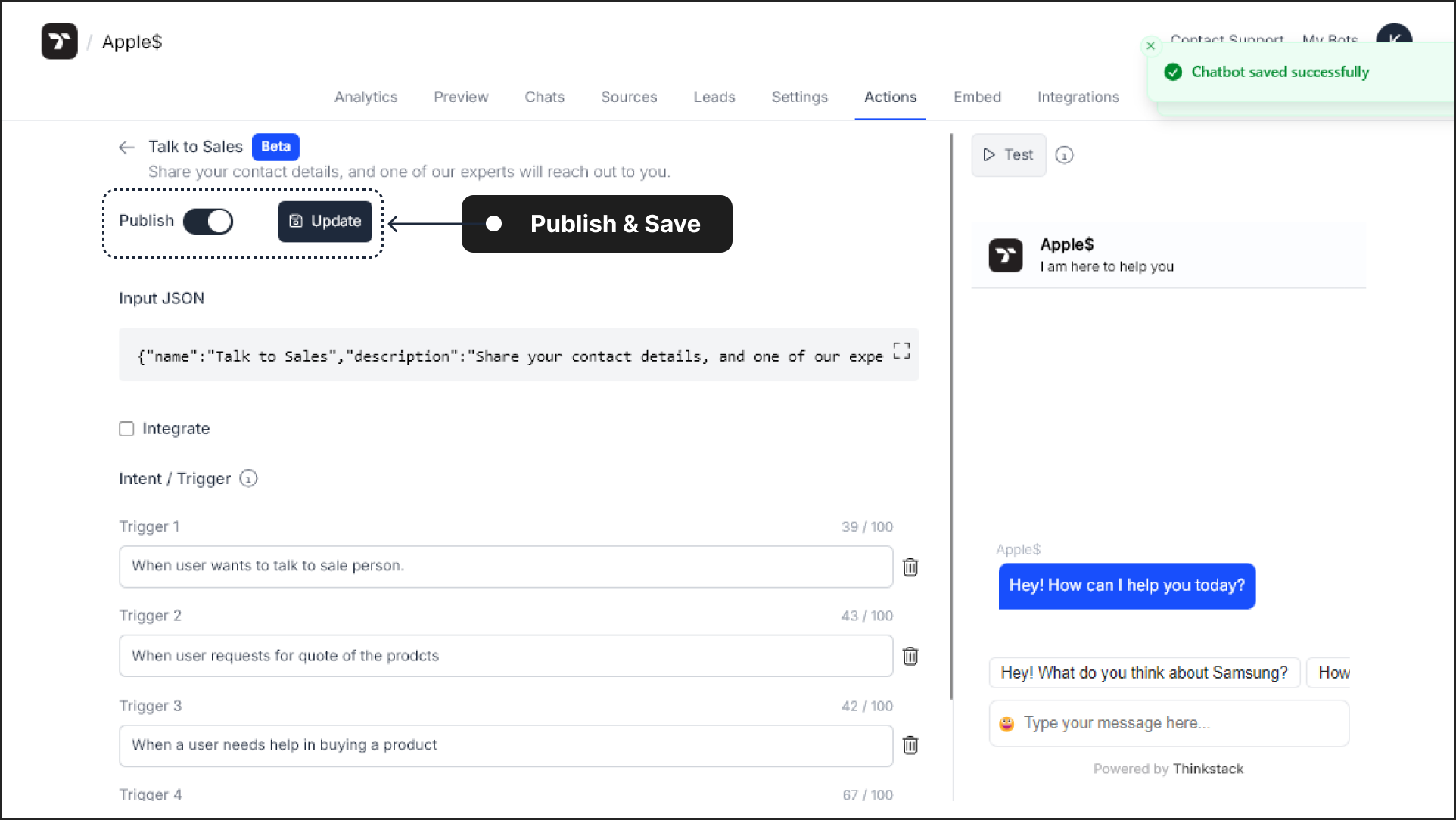
Talk to Sales Action: Advanced Settings#
If you'd like to initiate the action through suggestions, you can configure this easily:
Open the Advanced dropdown and toggle 'Show in Suggestions.'

Provide a Suggestion Title. When users click on it, the Talk to Sales action will be triggered.

Click Update to apply these changes to your chatbot.

Test the talk to sales action#
Use the Test feature to verify that the chatbot is correctly collecting the contact fields as configured in the
.jsonfile.
You can also test it in the Preview section to ensure the chatbot properly detects user interest and triggers the sales contact action.
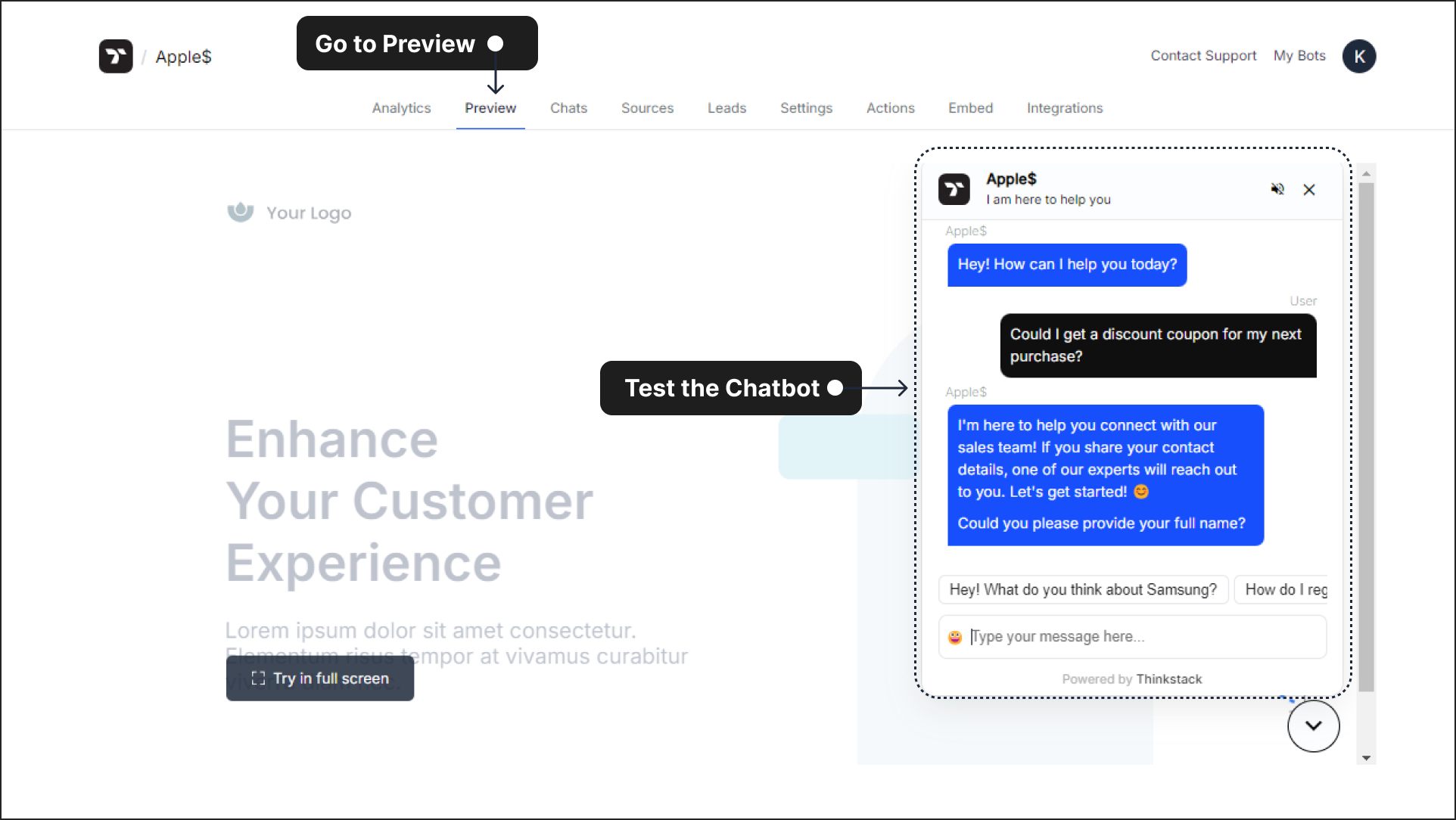
View the Contact Details#
Once the chatbot successfully collects the contact details, you can view them under the Talk to Sales section in the Actions tab.


That's a wrap! 🎉 You’ve successfully set up an intent-driven Talk to Sales action. The chatbot will gather client details, which the sales team can use to provide further assistance.
⚠️ How to Set Up a Reporting Issues Action ?
Report Issues Action Template#
Click on the bot for which you want to set up the action. Navigate to Actions in the top menu and select Report an issue from the list.

A
JSONtemplate will appear, pre-configured to collect issue details and create a support ticket. You can customize this template to fit your specific needs.
If you want to automate the action with third-party apps like Zapier, click Integrate. This step will trigger the Zap you have already set up. Note that this step is optional.

Set the Trigger to help the chatbot identify when to start the action of support tickcet creation. Carefully provide the triggers. Best practice is to use 2-3 distinct triggers to assist the chatbot in recognizing the intent.
 Note : Ensure the triggers you set are not the same as those used for Human-Handoff. If similar triggers are used, the chatbot will perform Human-Handoff instead of executing the report action.
Note : Ensure the triggers you set are not the same as those used for Human-Handoff. If similar triggers are used, the chatbot will perform Human-Handoff instead of executing the report action.After setting the triggers, toggle the Publish button to activate the reporting issues action. Click on 'Save' as this will save the changes/selection you have made so far with respect to the chatbot.

Report Issue Action: Advanced Settings#
If you want to initiate the action by adding it as a suggestion you can easily do so.
Open the Advanced dropdown and toggle 'Show in Suggestions.

Provide a Suggestion Title. When users click on it, the action of support ticket creation will be triggered.

Click on 'Update' to apply the new changes to your chatbot.

Test the Reporting Issues action#
Use the Test feature to verify that the chatbot is requesting the fields as configured in the
.jsonfile.
You can also test it in the Preview section to ensure the chatbot correctly identifies user intent and triggers the action for creating a support ticket.

View the Support Tickets#
Once the chatbot successfully creates a Support ticket, the details can be viewed by clicking on the Report an Issue list in the Action section.
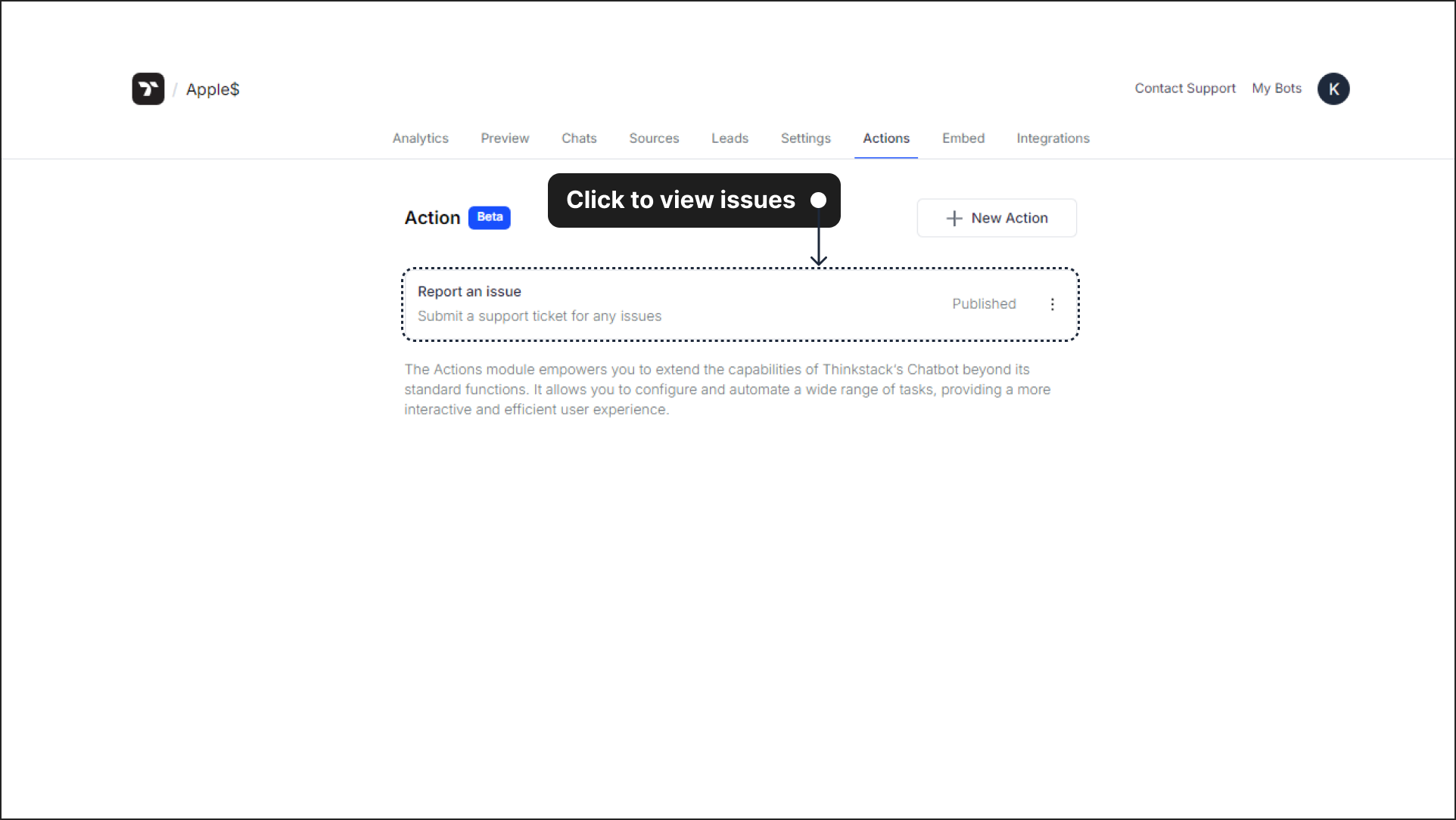
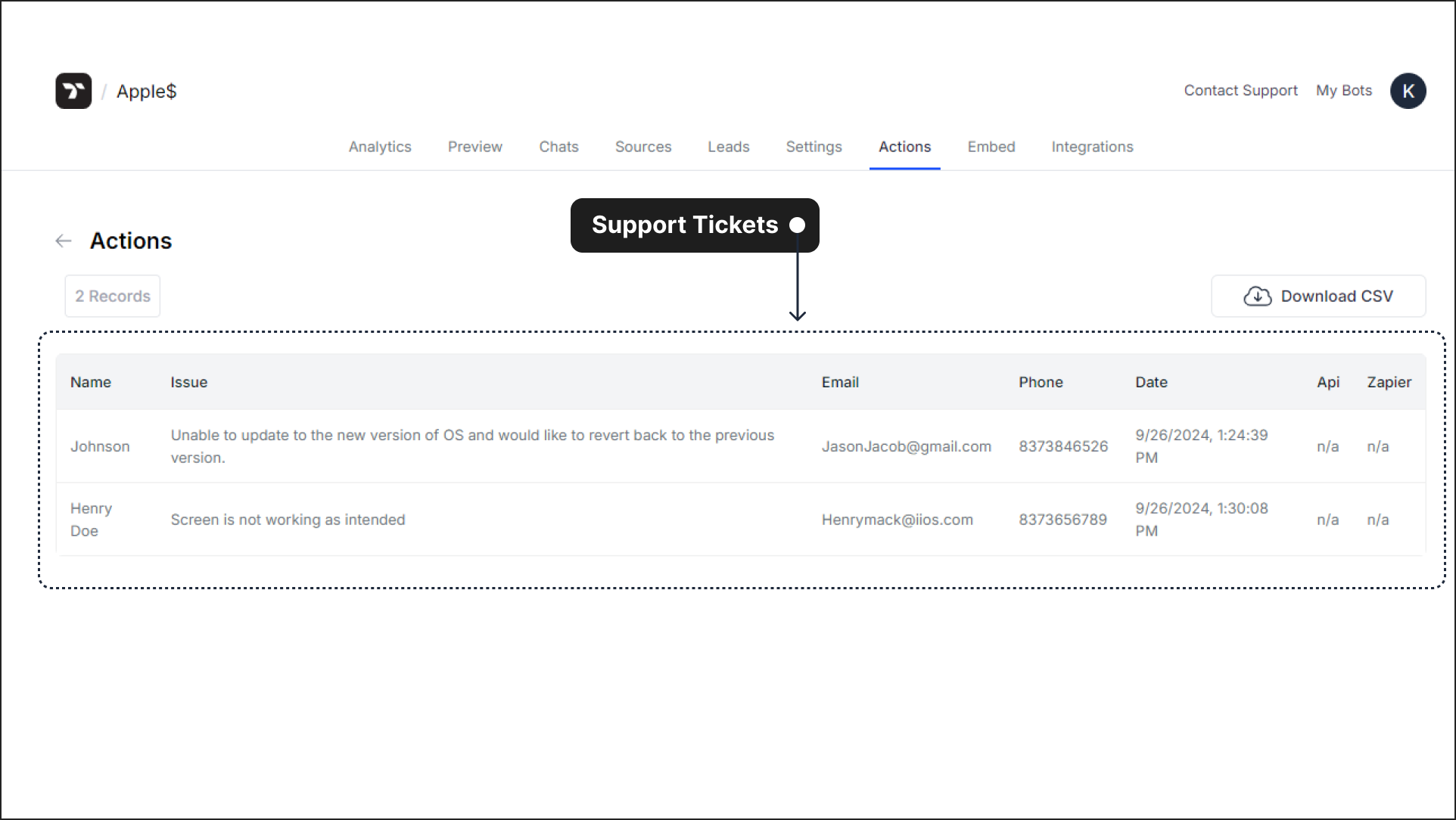
That's a wrap! 🎉 You've successfully set up an intent-driven Report an Issue - Action that will automatically create support tickets when the chatbot detects an issue being reported during a conversation.
⭐ How to Set Up a Customer Feedback Action ?
Collect Customer Feedback Action Template#
Click on the bot for which you want to set up the action. Go to the Actions tab in the top menu and select Customer Feedback from the list.

A
JSONtemplate will appear, pre-configured to collect user feedback through a form. The form will ask for details such as the user's full name, email address, overall experience rating, customer service satisfaction, likelihood of recommending the product/service, and permission to contact them for further feedback. You can customize this template to meet your specific needs.
If you wish to automate the feedback collection process with third-party apps like Zapier, click Integrate. This will trigger the Zap you've set up for this action. Note that this step is optional.

Set the Intent/Trigger: This helps the chatbot know when to initiate the customer feedback process. Carefully define the triggers, ideally using 2-3 distinct ones to assist the chatbot in recognizing user intent.
 Note: Ensure that the triggers do not overlap with those used for other actions to avoid confusion in the chatbot's response.
Note: Ensure that the triggers do not overlap with those used for other actions to avoid confusion in the chatbot's response.After setting the triggers, toggle the Publish button to activate the Customer Feedback action. Click Save to keep the changes you’ve made to the chatbot.

Feedback Action: Advanced Settings#
If you want to trigger the action through suggestions, you can configure this easily:
Open the Advanced dropdown and toggle 'Show in Suggestions.

Provide a Suggestion Title. When users click on it, the Customer Feedback process will start.

Click Update to apply these changes to your chatbot.

Test the Feedback Collection Action#
Use the Test feature to ensure the chatbot is correctly collecting the feedback fields as configured in the
.jsonfile.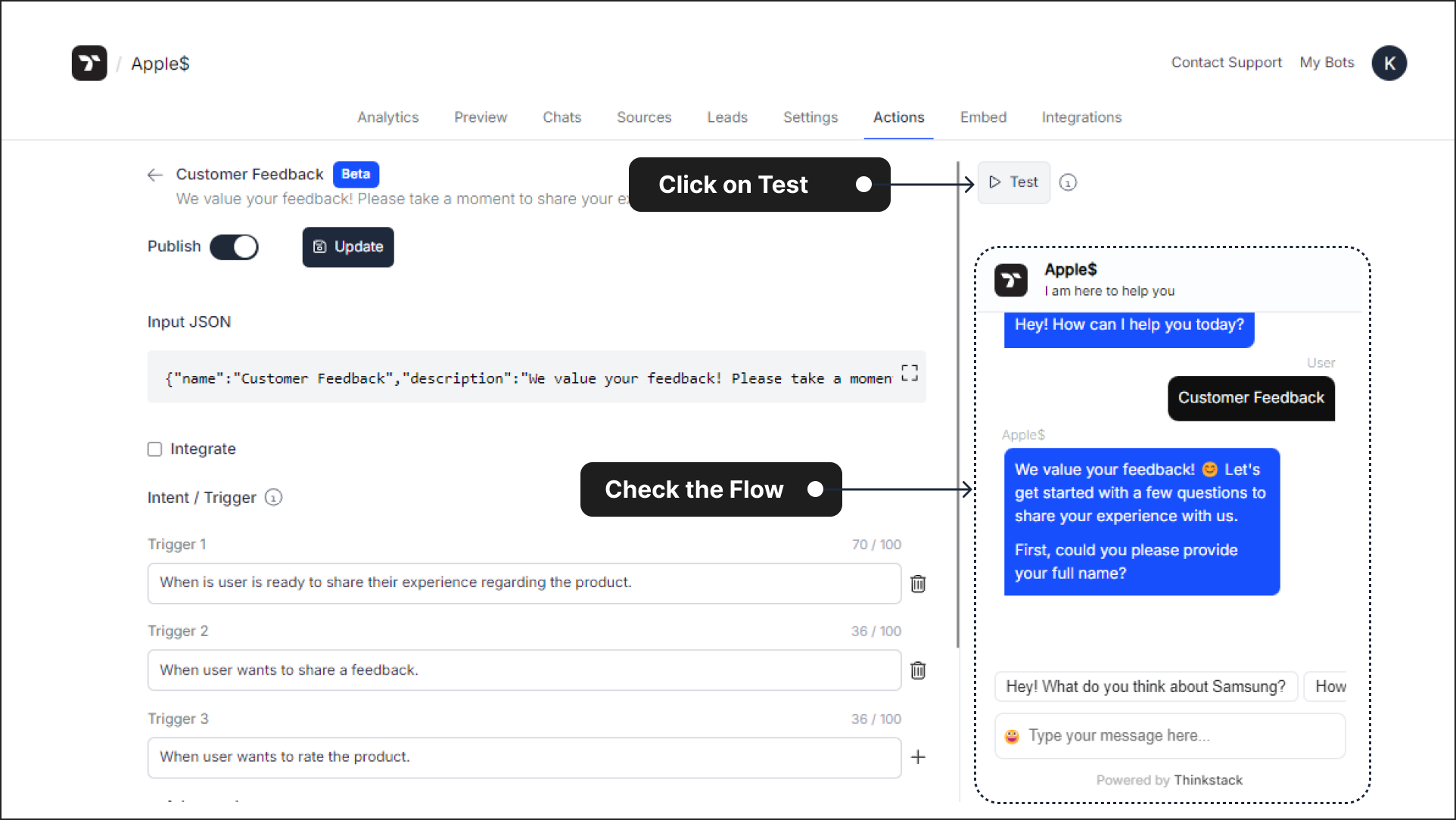
You can also test it in the Preview section to verify that the chatbot accurately detects when users want to provide feedback and triggers the feedback collection process.

View the Feedback Details#
Once the chatbot successfully collects the feedback details, you can view them in the Customer Feedback section of the Actions tab.


That's a wrap! 🎉 You’ve successfully set up an intent-driven Customer Feedback action that will help your team gather valuable insights from users when the chatbot detects interest in receiving feedback.